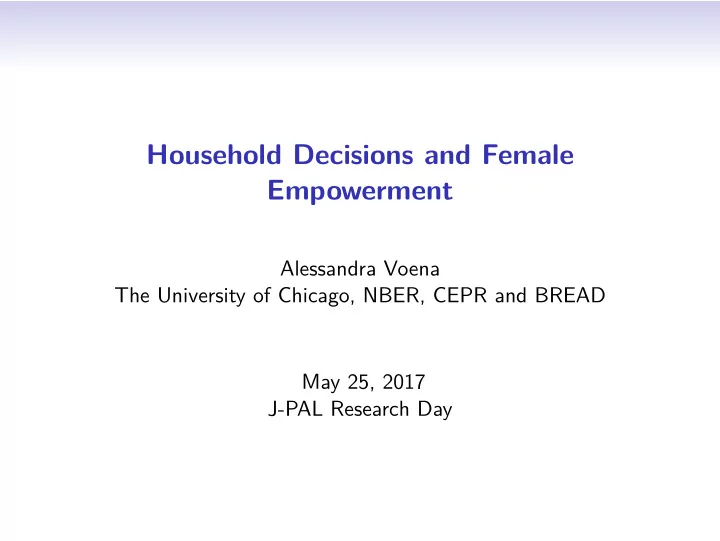

Household Decisions and Female Empowerment Alessandra Voena The University of Chicago, NBER, CEPR and BREAD May 25, 2017 J-PAL Research Day
Women’s empowerment Collective decision-making max c,Q u m ( c m , Q ) + µ ( p, y, z ) u f ( c f , Q ) s.t. x = p ( c m + c f ) + Q ≤ y m + y f Female empowerment in the household: • How closely do hh decisions incorporate the well-being of women? (How large is µ ?) • How do we measure female empowerment?
Consumption allocation within the household Using strong theoretical assumptions • Dunbar, Lewbel and Pendakur (AER 2012), Malawi: c f c m c kid x − Q = 30% , x − Q = 49% and x − Q = 10% • Cherchye, DeRock and Vermeulen (AER 2012), Holland 2008: c f + c m c f c k c f + c m + c k + Q = 21% , c f + c m = 16% , c f + c m = 49% • Voena (AER 2015), USA 1968-1993: c f x = 47% , c m x = 74%
Distribution of wives’ share of private consumption Source: Lise and Seitz (RESTUD 2012)
Bounds on wives’ share of consumption by income PSID (1999-2009) Source: Cherchye et al. (ECMA 2015)
Mean predicted women’s resource shares Calvi (2016): India (2011-2012)
Consumption allocation within the household Using direct data observation • Bonke and Browning (2009), Denmark 1999-2004: c f c f + c m = 53% • Dubois and Ligon (2009), Philippines 1984-1985: c f c f + c w = 45% (food expenditure only) • Kinnan et al. (in progress), China 1989-2009: c f c f + c w = 38% (food expenditure only)
Distribution of household expenditure Japanese Panel Survey of Consumption Source: Prepared by Yu Ushioda
Allocation shares versus wage shares Source: Lise and Yamada (2016), Japanese Panel Survey of Consumption
Measurement challenges 1. Interpretation challenges • Differences in preferences • Non-separability between consumption and leisure 2. Can we validate these consumption measures? • Ask multiple household members • Use multiple methodologies like diaries, questionnaires etc... • Relationship to BMI and health? 3. How do they correlate with other survey measures of empowerment? • E.g. questions on “who decides about what"
Recommend
More recommend